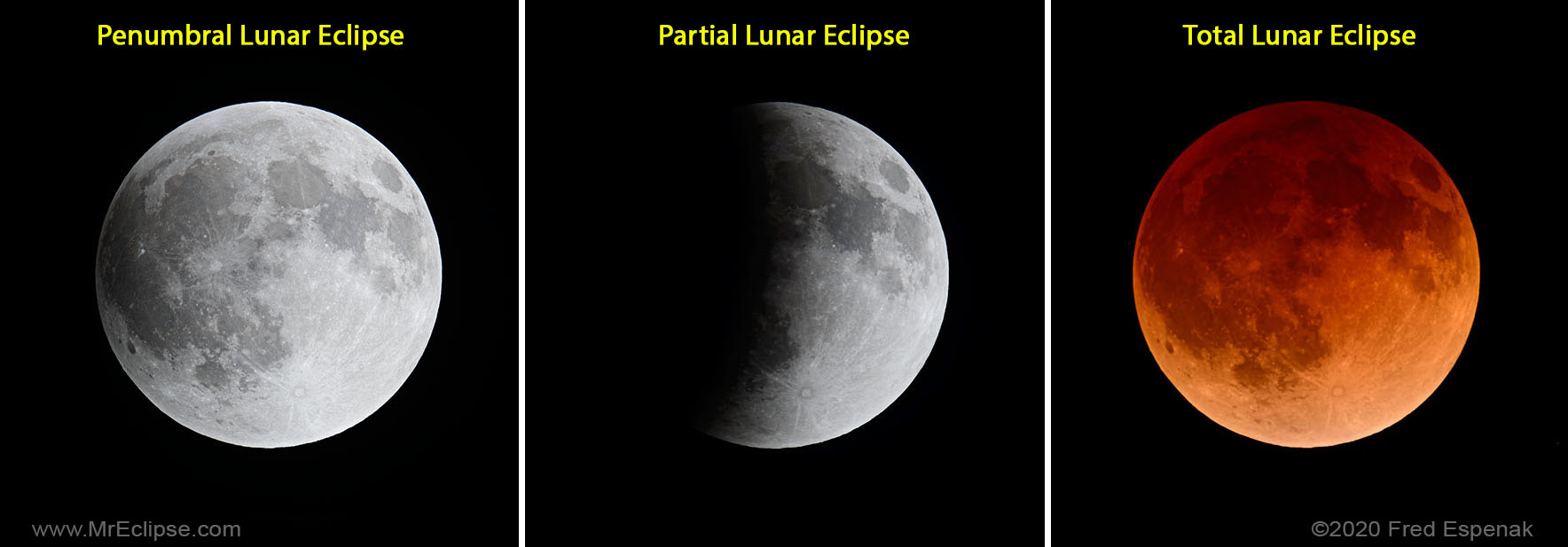Lunar Eclipse Basics
Fred Espenak
Based on Thousand Year Canon of Lunar Eclipses 1501 to 2500

A total lunar eclipse occurs when the Moon passes completely inside Earth's dark umbral shadow.
Lunar Eclipse Fundamentals
The Moon orbits Earth once every ∼29.5306 days with respect to the Sun. Over the course of its orbit, the Moon's changing position relative to the Sun results in its familiar phases: New Moon > New Crescent > First Quarter > Waxing Gibbous > Full Moon > Waning Gibbous > Last Quarter > Old Crescent > New Moon. The New Moon phase is not visible because the illuminated side of the Moon points away from Earth. The other phases are easily seen as the Moon cycles through them month after month.
During Full Moon, the Moon appears opposite the Sun in the sky. It rises as the Sun sets and is visible throughout the night. The Full Moon sets in the morning just as the Sun rises. This unique geometry occurs when the Moon is 180° from the Sun as seen from Earth. This is also the direction that Earth casts its shadow into space.
The Moon’s orbit is tilted about 5.1° to Earth’s orbit around the Sun. The apparent points where the two orbits cross are called the nodes. When the Full Moon occurs near one of these nodes, the Moon may pass through some portion Earth's shadow and a lunar eclipse takes place.
Earth’s shadow is composed of two cone-shaped components, one nested inside the other. The outer or penumbral shadow is a zone where the Sun's rays are partially blocked. In contrast, the inner or umbral shadow is a region where direct rays from the Sun are completely blocked.

Three Types of Lunar Eclipses: Penumbral, Partial, and Total.
Types of Lunar Eclipses
There are three types of lunar eclipses:
- Penumbral - The Moon passes through Earth's faint penumbral shadow. Penumbral eclipses are of minor interest since they are quite difficult to observe. Although rare, a penumbral eclipse can occur in which the Moon’s entire disk is enveloped within the penumbra. Such events are called total penumbral eclipses.
- Partial - A portion of the Moon passes through Earth's dark umbral shadow. The remaining part of the Moon appears bright even though it lies deep within the penumbra. Partial eclipses are easy to see, even with the unaided eye.
- Total - The entire Moon passes through Earth's umbral shadow.
Total eclipses are quite striking for the vibrant range of colors the Moon can take on during the total phase, referred to as totality.
Furthermore, total eclipses can be classified as either central or non-central.
The visual appearance of each of these eclipse types differs dramatically from one another.
The recurrence of lunar eclipses is governed by the Saros cycle. For more information, see Periodicity of Lunar Eclipses.

Depending on its path through Earth's shadows, a lunar eclipse may be 1) penumbral, 2) partial or 3) total.
Lunar Eclipse Dates
By convention, the date and time used to identify a lunar eclipse is the instant of greatest eclipse. This time corresponds to the instant when the center of the Moon passes closest to the axis of Earth’s shadow. While the instant of greatest eclipse is used to indentify an eclipse, the eclipse itself generally lasts several hours and may span across two days.
The instant of greatest eclipse is usually expressed in either Terrestrial Dynamical Time (TD) or Universal Time (UT1). The parameter ΔT is used to convert between these two times (i.e., TD = UT1 + ΔT).
Calendar
The Gregorian calendar (also called the Western calendar) is internationally the most widely used civil calendar. It is named for Pope Gregory XIII, who introduced it in 1582. On this website, the Gregorian calendar is used for all calendar dates from 1582 Oct 15 onwards. Before that date, the Julian calendar is used. For more information on this topic, see Calendar Dates. The Julian calendar does not include the year 0. Thus the year 1 BCE [1] is followed by the year 1 CE (See: BCE/CE Dating Conventions ). This is awkward for arithmetic calculations. Years in this catalog are numbered astronomically and include the year 0. Historians should note there is a difference of one year between astronomical dates and BCE dates. Thus, the astronomical year 0 corresponds to 1 BCE, and astronomical year -1 corresponds to 2 BCE, etc..
Footnotes
[1] The terms BCE and CE are abbreviations for "Before Common Era" and "Common Era," respectively. They are the secular equivalents to the BC and AD dating conventions. (See: Year Dating Conventions )
Links to Additional Lunar Eclipse Predictions
- Home - home page of EclipseWise
- Lunar Eclipses - primary page for lunar eclipse predictions
- Lunar Eclipse Links - detailed directory of links
- Six Millennium Catalog of Lunar Eclipses - covers the years -2999 to +3000 (3000 BCE to 3000 CE)
- Javascript Lunar Eclipse Explorer - calculate all lunar eclipses visible from a city
- Thousand Year Canon of Lunar Eclipses 1501 to 2500 - link to the publication
- MrEclipse.com - Eclipse resources and tips on photography
- Lunar Eclipses for Beginners - a primer on lunar eclipses
- How to Photograph a Lunar Eclipse - instructions for imaging an eclipse of the Moon
- MrEclipse Photo Index - an index of lunar eclipse photographs
Eclipse Predictions
The eclipse predictions presented here were generated using the JPL DE406 solar and lunar ephemerides. The lunar coordinates have been calculated with respect to the Moon’s Center of Mass.
Acknowledgments
Some of the content on this web site is based on the book Thousand Year Canon of Lunar Eclipses 1501 to 2500. All eclipse calculations are by Fred Espenak, and he assumes full responsibility for their accuracy. Permission is granted to reproduce data from this page when accompanied by an acknowledgment:
"Eclipse Predictions by Fred Espenak, www.EclipseWise.com"






